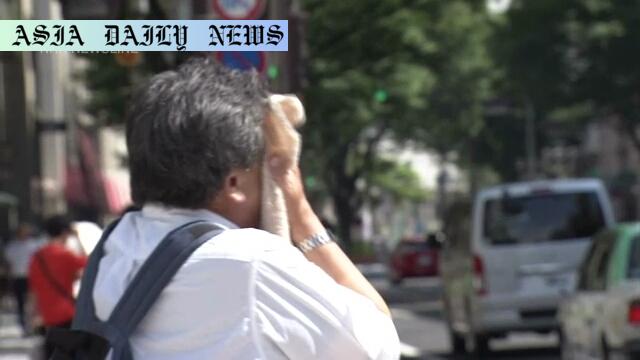Heatwave: Daytime highs hit above 35 degrees in 22 locations across Japan, with high temperatures predicted to persist.

Record-breaking Heatwave Sweeps Across Japan
Japan has been gripped by an oppressive heatwave, with temperatures surging above 35 degrees Celsius in wide-reaching areas. On Monday, the searing heat impacted regions stretching from Kyushu to Hokuriku, with temperatures hitting as high as 36.5 degrees in Saijo City, Ehime Prefecture. This remarkable rise has drawn attention as Tokushima City registered its highest temperature for June since records began in 1891, reaching a sweltering 36.2 degrees. The Japan Meteorological Agency (JMA) attributes the extreme conditions to the influx of warm air driven by a strong high-pressure system dominating the region.
Widespread Heat Risks Across Major Cities
The heatwave has extended its grip to several major cities, with Osaka and Nagoya recording 33.6 and 33.5 degrees Celsius, respectively, and the mercury in central Tokyo climbing to 31.6 degrees. Forecasts for Tuesday predict equally scorching conditions, with Kumagaya and Maebashi cities expected to hit 36 degrees and Tokyo expected to experience temperatures nearing 34 degrees. The prolonged exposure to these scorching temperatures has prompted officials to issue alerts, urging the public to take precautions against heat-related ailments such as heatstroke, particularly during the peak daytime hours.
Unstable Atmospheric Conditions – A Double Threat
While the heatwave causes sweltering conditions, meteorologists are cautioning about another atmospheric phenomenon—unstable weather patterns. The passage of a weather front may bring localized thunderstorms, gusty winds, and even the possibility of tornadoes. Regions in western Japan are vulnerable to heavy rains accompanied by thunder during the morning, with eastern Japan at risk later in the day into the night. Citizens have been advised to prepare for sudden weather changes, keeping an eye out for violent gusts or lightning strikes.
Preventive Measures to Combat the Heat
In light of the record-breaking temperatures, health officials are emphasizing several measures to help citizens stay safe. Staying hydrated and avoiding outdoor activities during peak heat hours are vital. Utilizing air-conditioning and engaging in short cooling breaks can alleviate heat stress significantly. Special attention is being advised for the elderly, young children, and individuals with pre-existing health conditions as they are particularly vulnerable to heat-related illnesses.
Looking Ahead: High Temperatures to Persist
Japan’s weather agency predicts that warm air from the high-pressure system will continue to affect temperatures over the coming days. While daytime highs are expected to dominate headlines, local authorities encourage vigilance for sudden shifts in weather patterns. By enacting simple measures, individuals can ensure their safety while weathering the heat and possible thunderstorms.
Commentary
A Closer Look at Japan’s Record-breaking Heatwave
The ongoing heatwave in Japan is a stark reminder of the growing challenges posed by climate variability. With temperatures climbing well into the mid-thirties in what ought to be early summer, the recent weather patterns have sparked widespread discussions concerning preparedness and adaptation. High-pressure systems, often responsible for much of the summer heat, seem to have started earlier than expected this year. It leaves one pondering whether this is an anomaly or part of a seasonal trend exacerbated by global warming.
Impact on Daily Lives
The relentless temperatures have taken a toll on citizens’ everyday lives, forcing many to modify their routines. Outdoor laborers find themselves particularly vulnerable, with the risk of heatstroke soaring during peak daytime hours. Schools and institutions are also grappling with the challenge of keeping students safe and hydrated while maintaining regular schedules. Such extreme weather events underline the importance of public health awareness campaigns. They ensure that everyone, particularly vulnerable populations, is equipped with knowledge and resources to endure the heat safely.
Lessons on Preparedness
Japan’s approach to managing this heatwave demonstrates commendable foresight, from weather advisories to public health announcements. Nevertheless, there is room for improvement in integrating long-term strategies to combat such extremes. Green infrastructure, including urban shading and reflective street materials, could offer much-needed relief in urban centers. Public access to cooling centers could also prove invaluable in mitigating the impacts of such events in the future, especially as weather records continue to break with alarming frequency around the globe.
Final Reflection
While Japan’s heatwave is an immediate concern, it also serves as a clarion call to address broader environmental concerns. Whether through individual action, community-driven initiatives, or governmental intervention, a cohesive response to climate change remains imperative. By taking these experiences as an opportunity for learning and growth, societies worldwide can take proactive measures to face the ongoing challenges of a rapidly warming planet.


